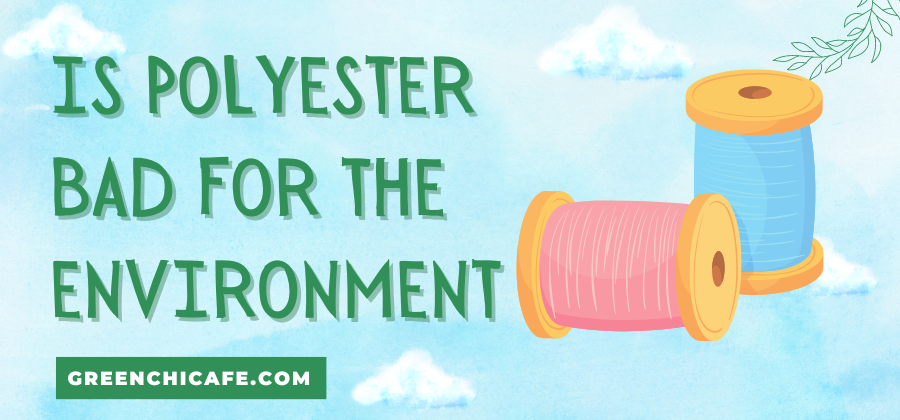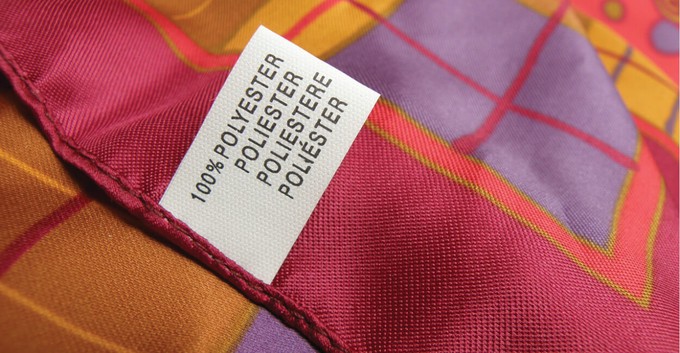Polyester has become an incredibly common fabric in today’s world of fast fashion and cheap clothing.
While polyester does have some negative impacts, it also offers certain benefits over natural fabrics like cotton.
This article will explore the main pros and cons of polyester and look at whether it can be considered sustainable.
Is Polyester Bad for the Environment?
Polyester fabric does harm the environment overall.
While it offers some benefits over natural fibers like cotton, the manufacturing process of virgin polyester without recycling plastic waste is quite harmful.
Polyester’s lack of biodegradability also makes it a big contributor to plastic pollution in landfills and waterways.
And the microfibers shed from polyester fabrics are problematic.
Recycled polyester helps mitigate some of these issues and is a step forward.
But even recycled polyester takes centuries to decompose.
More work needs to be done by polyester producers to improve sustainability and tackle problems like microplastic pollution.
Key Points
- Polyester production emits greenhouse gases and utilizes substantial amounts of energy and water.
- Polyester does not biodegrade easily and takes centuries to decompose, polluting landfills.
- Microfibers released from polyester during laundering cause widespread microplastic pollution.
What are the main environmental issues caused by polyester fabric production?
The production of polyester fabric relies heavily on non-renewable resources.
Polyester is made from petroleum, a non-renewable fossil fuel.
Extracting and refining petroleum emits air pollutants and greenhouse gases like carbon dioxide.
The manufacture of polyester also requires substantial amounts of water and energy.
Dyeing and treatment processes utilize toxic chemicals that get discharged into wastewater, polluting waterways.
Does polyester biodegrade or is it essentially plastic waste?
One of the biggest issues with polyester is that it does not easily biodegrade.
Just like plastic bottles, polyester fabric can take up to 200 years to decompose.
That means polyester clothing, when thrown away, sits in landfills for centuries without breaking down.
As polyester items get washed, they also shed microplastic fibers that make their way into water systems, contaminating marine environments.
These microplastics can be ingested by sea creatures and make their way up the food chain.
Does polyester off-gas or leach any chemicals that can impact human health?
Polyester is hydrophobic and quick drying.
To make it absorbent, antimicrobial chemicals are added to polyester during manufacturing.
Studies show that these added chemicals can off-gas or leach from polyester fabric, causing skin irritations and respiratory issues.
Formaldehyde is one such chemical that gets released.
Another potential health concern is antimony, a carcinogen used as a catalyst in polyester production.
So, while pure polyester may be hypoallergenic, added chemicals pose health risks.
Does the production of polyester fabric consume a lot of water?
The manufacture of polyester is water-intensive, requiring over 100 liters of water to produce one kilogram of the material.
Polyester production utilizes water for cooling during processes like melt-spinning.
Water is also used for dyeing and finishing polyester fabrics before they hit retail shelves.
Much of this water becomes contaminated with toxic chemicals, acids, and dyes and must be treated before being discharged as effluent.
In water-stressed regions, the high water usage for polyester is problematic.
What kind of air and water pollutants are generated by polyester production?
The production of polyester generates substantial air pollution.
Carbon dioxide is released during raw material extraction and processing.
Volatile organic compounds or VOCs are also emitted when solvents are used to manufacture polyester.
Dioxins and carcinogenic compounds can be formed during certain production processes.
Wastewater from polyester mills contains toxic substances like antimony, cobalt, and manganese salts, which leach into water bodies causing contamination.
Without proper treatment, these pollutants negatively impact the environment.
How Does Polyester Fabric Compare to Natural Fibers Like Cotton in Terms of Sustainability?
When comparing polyester and cotton, there are trade-offs to consider.
Polyester has larger environmental impacts across its lifecycle.
The manufacturing process to produce polyester fabric is more energy and water-intensive than growing cotton.
It also relies on crude oil, a nonrenewable resource.
However, cotton farming utilizes vast amounts of water too, especially in regions already experiencing water scarcity.
Growing cotton also involves heavy use of pesticides and fertilizers, which can leach into and contaminate groundwater and rivers.
The chemicals used to dye and treat polyester fabric also pollute waterways.
So, neither fiber has a perfect track record when it comes to water pollution.
In terms of land usage, cotton again requires more acres of arable land devoted to its cultivation than manufacturing polyester.
But polyester production does indirectly contribute to oil drilling and extraction activities that disrupt wildlife.
When it comes to emissions, polyester generates higher levels of CO2 emissions compared to cotton.
But cotton farming still produces significant agricultural emissions, including methane.
A key difference is that polyester fabric, being plastic-based, does not biodegrade quickly whereas cotton decomposes within months.
So, polyester sits in landfills for centuries.
Overall, while cotton may edge out polyester in some sustainability metrics, it comes with major environmental issues too.
Opting for organic cotton helps mitigate concerns about pesticides and land use.
But challenges around water use during farming persist.
What Are the Risks Posed by the Microplastic Pollution Caused by Polyester Garments?
Tiny plastic microfibers detach from polyester fabric and enter waterways when garments are washed.
Being plastic-based, these microfibers do not biodegrade quickly.
Marine animals may consume these thinking they are food.
Subsequently, microplastics enter our food chain as humans eat seafood.
Research on the effects of ingesting microplastics is still ongoing.
But initial studies on animals and humans indicate potential interference with hormones, reproduction, metabolism, and growth.
Lab studies on fish have shown liver stress and ruined gills due to ingested microplastics.
Polyester microfibers are one of the biggest contributors to microplastic pollution in oceans, second only to microbeads from cosmetics and personal care products.
And there are currently no existing filtration solutions that can effectively trap these tiny synthetic fibers during the laundering process.
The durability of polyester that makes it wrinkle-resistant also means the microfibers persist for a long time once shed.
As they degrade further, they fragment into tinier and tinier plastic particles, making remediation even harder.
The accumulation of microplastics has also been shown to transport pathogenic bacteria and algae, adding another element of risk, especially for marine ecosystems.
More research is still required to fully understand the impacts of microplastic pollution on environmental and human health.
But the scale of the issue makes it crucial we find solutions now before the problem gets harder to reverse.
Is Landfilling or Incinerating Polyester Worse for the Planet?
Discarding polyester fabric in landfills is deeply problematic for a few key reasons.
First, polyester is designed to be durable, so it takes an extremely long time to break down up to 200 years.
As it slowly degrades, polyester releases methane, a greenhouse gas much more potent than carbon dioxide.
Landfilling polyester also causes plastic pollution as tiny microfibers detach and leach into groundwater and the surrounding soil.
This plastic contamination spreads the problem.
When polyester sits in crowded landfills, it also takes up precious space and represents a waste of resources that could have been recycled.
Even recycled polyester cannot be recycled again after use.
Incinerating polyester also comes with risks, primarily the release of air pollutants.
While pure polyester emits minimal fumes when burned, textiles often have chemical dyes, coatings, and finishes applied that can release hazardous fumes upon burning.
The ash residue can contain heavy metals.
In terms of carbon emissions, incinerating polyester into ash still releases substantial CO2, roughly the same as landfilling polyester.
Energy can be recovered from polyester incineration, but the highly pollutive nature of the process makes the energy difficult to count as green.
Considering the huge volumes of textile waste we produce, neither landfilling nor incineration are sustainable strategies.
The ideal solution is to drastically ramp up textile recycling efforts and reuse polyester rather than dispose of it.
Manufacturers also need to design durable polyester that can be recycled multiple times.
What Are the Pros and Cons of Choosing Recycled vs Virgin Polyester?
Opting for recycled polyester offers important benefits from an environmental standpoint.
Recycling polyester involves collecting and processing used polyester items, like plastic bottles, and turning them into usable polyester fiber.
Producing recycled polyester generates substantially fewer carbon emissions compared to manufacturing virgin polyester from raw materials.
It also utilizes less water and energy overall.
Recycled polyester relies on existing plastic waste sources rather than extracting and refining crude oil to make virgin polyester.
This reduces dependence on fossil fuels and prevents PET plastics from ending up in landfills or the ocean.
However, recycled polyester does not biodegrade any faster than virgin polyester.
Both take hundreds of years to break down, so microfiber pollution concerns persist.
A limitation of recycled polyester is that fabrics made from it cannot be recycled again after their usable life.
So, it only partially closes the loop on textile waste.
More transparency is also needed on social impacts as plastic recycling processes are frequently outsourced to countries with lower regulations and labor standards.
The scale of textile waste globally also means we likely cannot recycle our way out of the problem yet.
Though helpful, recycled polyester currently makes up less than 1% of total polyester in production.
Substantially ramping up recycling infrastructure is essential.
So while recycled polyester offers clear advantages, it is not a perfect solution.
Virgin polyester fabric produced in a closed-loop, eco-friendly manner would be more sustainable than simply producing more and more recycled fabric.
The ideal scenario would be integrating both closed-loop manufacturing and circular recycling.
The bottom line
The bottom line is that polyester has advantages but also some clear disadvantages from an environmental standpoint.
Producing virgin polyester fabric without recycling existing plastic waste harms the planet.
But recycled polyester, which converts waste into usable material, offers a more eco-friendly alternative.
Polyester won’t decompose quickly regardless of whether it’s recycled.
But it provides certain benefits over plant-based options like cotton that also have sustainability issues around farming.
The durability and longevity of polyester can be an asset in a world grappling with textile waste and fast fashion.
But more transparency is needed around production practices and chemical usage.
And effective solutions have to be implemented to tackle microfiber pollution.
With some improvements, polyester could be an environmentally responsible choice for clothing and textiles.
But in its current form, virgin polyester without recycling falls short of a truly sustainable fabric.
FAQ
What Types of Chemicals Are Used to Make Polyester Fabrics?
Polyester production involves chemicals like antimony, which is a known carcinogen, and cobalt and manganese salts which can leach into waterways. Additional finishing chemicals containing volatile organic compounds are also applied to polyester fabrics.
How Much Water Is Used to Produce Polyester?
It takes over 100 liters of water to manufacture just one kilogram of polyester material. This water usage is problematic in water-stressed regions. The discharged wastewater also contains chemical pollutants.
Does Recycled Polyester Biodegrade Faster Than Virgin Polyester?
No, recycled polyester does not biodegrade any quicker than virgin polyester. Both take hundreds of years to decompose. The advantage of recycled polyester lies in reusing existing plastic waste.
Does Polyester Microfiber Pollution Impact Human Health?
Research indicates that ingesting microplastics from water and seafood may interfere with hormones, reproduction, and growth in humans. Polyester microfibers are a major contributor to this plastic pollution.
Is Polyester Worse for the Planet Than Cotton?
Polyester has a larger carbon footprint compared to cotton overall. But cotton farming also utilizes substantial amounts of water and land and relies heavily on pesticides. Both natural and synthetic fibers come with environmental trade-offs.
The team at GreenChiCafe is passionate about our fragile environment and the preservation of our natural world. We believe in making choices that have the least negative impact on our planet. Please visit our website for more content on leading greener lives.

Annie is a passionate environmental writer and activist. She has been writing about sustainability, conservation, and green living for over 15+ years. Annie is dedicated to raising awareness about environmental issues and providing practical tips for living an eco-friendly lifestyle. When she’s not writing, you can find her volunteering with local environmental organizations, teaching workshops on zero waste living, or exploring nature. Feel free to get in touch with Annie: annie@greenchicafe.com


